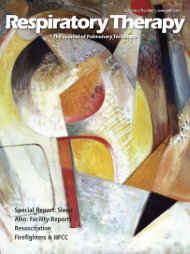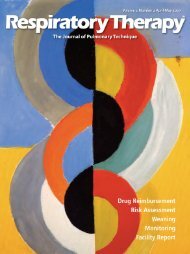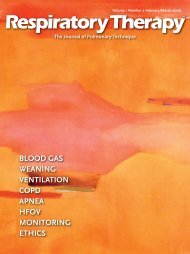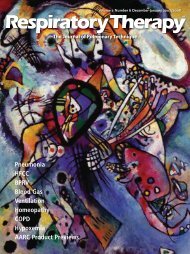RT 02-03 JJ07 main web - Respiratory Therapy Website
RT 02-03 JJ07 main web - Respiratory Therapy Website
RT 02-03 JJ07 main web - Respiratory Therapy Website
Create successful ePaper yourself
Turn your PDF publications into a flip-book with our unique Google optimized e-Paper software.
seldom occur in subjects with normal upper airway mechanics<br />
during wakefulness, suggesting the involvement of other<br />
pathogenetic factors.<br />
Although our snorers had similar age, gender and BMI without<br />
obvious cranio-facial and ORL anomalies, lateral cephalometry<br />
or MRI studies of the pharynx were not performed, so we<br />
cannot exclude minor anatomic abnormalities in bony structure<br />
or soft tissue around the pharyngeal airway in OSAH patients.<br />
Conversely, careful inspection of the maximal and tidal<br />
expiratory flow-volume curves allowed us to rule out the<br />
presence of intrathoracic expiratory flow limitation during<br />
resting tidal breathing in all subjects. Therefore, we are<br />
confident that our subjects had no intrathoracic expiratory flow<br />
limitation which might have influenced the upper airway-related<br />
expiratory flow dynamics when NEP was applied.<br />
The usefulness of the NEP method to assess the upper airway<br />
collapsibility was previously tested in 16 awake subjects known<br />
to suffer from sleep-disordered breathing. 27 In contrast to<br />
snorers, all patients with OSAH (n = 8) showed a substantial<br />
portion (>30%) of the expiratory tidal volume throughout the<br />
NEP application (-5 cmH 2O, in the supine position) with lesser<br />
expiratory flow than the one recorded during the previous<br />
control tidal expiration.<br />
Subsequently, in a group of 19 patients with OSAH when NEP<br />
was applied (-5 and -10 cmH 2O, in the supine position) the<br />
expiratory flow was reduced, when compared with the<br />
corresponding spontaneous expiratory flow, during a relevant<br />
part of the tidal expiration (>20%) in those (n = 13) with a<br />
higher mean apnea-hypopnea index (AHI). 28<br />
In these studies a significant correlation was found between the<br />
percentage of the tidal volume during the NEP application with<br />
lower expiratory flow than during the spontaneous breathing<br />
and oxygen desaturation index (ODI), in the former, and ODI<br />
and AHI, in the latter. 27,28 Hence, the NEP method appeared<br />
suitable in order to detect an increased pharyngeal collapsibility<br />
in patients with OSAH during wakefulness and perhaps able to<br />
predict the severity of OSAH.<br />
Recently, using the same criteria, a large cohort of snoring<br />
subjects was examined to assess the capacity of the NEP<br />
method to screen apneic from non-apneic subjects. 29 In this<br />
study a sensitivity of 81.9% and specificity of 69.1% in predicting<br />
OSAH was found when the expiratory flow during NEP (-5<br />
cmH 2O in supine position) was below that of the previous<br />
control expiration for ≥27.5% of the tidal volume. In addition, a<br />
significant correlation between NEP induced flow analysis and<br />
OSAH severity, as assessed by AHI, was found in the supine<br />
position using -5 cmH 2O of NEP with a coefficient value (r s =<br />
0.51) similar to the one we obtained in the severe OSAH patients<br />
(r s = 0.46).<br />
All of these studies, however, are based on the assumption that<br />
abnormal upper airway collapsibility is present or can be<br />
identified only when the expiratory flow during NEP becomes<br />
lower than the control one. Moreover, such finding has been<br />
erroneously taken as a marker of expiratory flow limitation. In<br />
contrast, an increased pharyngeal collapsibility can also be<br />
reflected by a smaller increase of expiratory flow during NEP.<br />
We believe that this flow has to be measured whether or not it is<br />
higher, lower or initially higher and then lower (or vice versa)<br />
than the flow of the previous tidal expiration. Indeed, judging as<br />
abnormal (or quantifying the severity of) the upper airway<br />
collapsibility only by computing the percentage of the tidal<br />
volume where the expiratory flow during NEP application<br />
becomes lesser than the one exhibited in the previous<br />
expiration is a poorly reliable tool. This is because such<br />
measure is too dependent from the preceding control tidal<br />
breathing and because the expiratory flow profile is often<br />
erratic in the same subject during repeated NEP tests; in<br />
addition, several apneic patients do not show such phenomenon<br />
constantly. 27-29 In order to overcome these problems, recently<br />
Tamisier and colleagues investigated a quantitative index<br />
corresponding to the ratio of the area under the expiratory<br />
flow/volume curves between NEP (-5 and -10 cmH 2O) and<br />
atmospheric pressure for the same tidal volume in awake<br />
subjects with sleep disordered breathing (SDB) and control<br />
subjects, both in supine and sitting position. 30 They found that<br />
this index was significantly different between controls and SDB<br />
subjects in all measurements, decreasing with the severity of the<br />
SDB. Moreover, in the supine position when -5 cmH 2O NEP was<br />
applied, a given threshold of this index had a positive predictive<br />
value of 88.6% and a negative predictive value of 80% to screen<br />
subjects with SDB. The Authors concluded that the NEP-related<br />
quantitative index may be useful to detect abnormal upper<br />
airway collapsibility in awake subjects with SDB. However,<br />
some limits of this study are obvious such as the lack of<br />
subjects with mild OSAH (AHI 5) and the age of the<br />
controls who were much younger (34 ± 12 yrs) than the patients<br />
with OSAH. Furthermore, the application of NEP near end<br />
expiratory lung volume tends to elicit reflex activation of<br />
genioglossus. 22 This can unpredictably influence the area under<br />
the final part of the expiratory flow/volume curve during NEP<br />
both in controls and SDB subjects, affecting the quantitative<br />
index used to assess the upper airway collapsibility.<br />
In a very recent paper Insalaco and coworkers used the drop of<br />
expiratory flow under NEP (ΔV-NEP), expressed as percentage<br />
change of peak expiratory flow under NEP, as index of upper<br />
airway collapsibility to detect OSAH in patients with sleep<br />
disordered breathing. Although this index was a better indicator<br />
of OSAH severity when compared to the previous ones, they<br />
reported, at best, a determination coefficient equal to 0.32<br />
between the AHI and ΔV-NEP, 31 using NEP of -10 cmH 2O in the<br />
supine position. An inherent problem with this approach is that<br />
ΔV-NEP does not take into account the duration of the<br />
expiratory flow drop under the NEP application, while it is very<br />
clear from the flow-time tracings given by the same Authors that<br />
this transient may last very differently with the same percentage<br />
value of reduction.<br />
By time-integration of the expiratory flow in the first 0.5 and 1<br />
sec after the application of a given level of NEP one can easily<br />
calculate the expiratory volume exhaled in a preset time in a<br />
given body position during wakefulness and use this parameter<br />
as an index of the mechanical properties of the upper airways at<br />
the onset of expiration when the genioglossus does not appear<br />
reflexively activated. 22 Therefore, the novelty of this study is the<br />
utilization of a method which, still adopting the NEP technique,<br />
is more reliable to assess and measure the upper airway<br />
collapsibility because it is quantitative, and it is not influenced<br />
by the flow of the preceding tidal expiration and by the effect of<br />
neuromuscular factors.<br />
V,NEP 0.5 and V,NEP 1 values were reduced in the supine position<br />
68 <strong>Respiratory</strong> <strong>Therapy</strong> Vol. 2 No. 3 � June-July 2007











